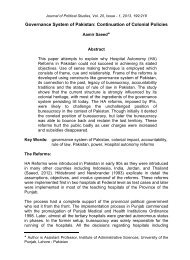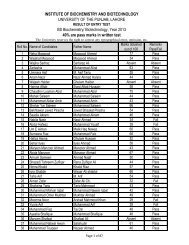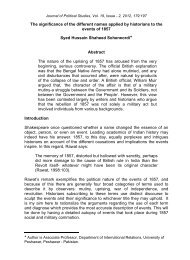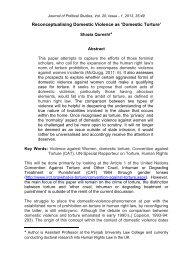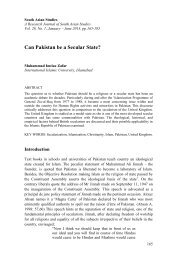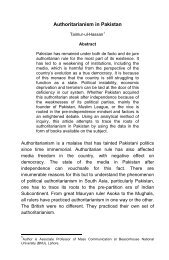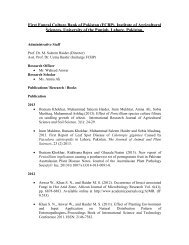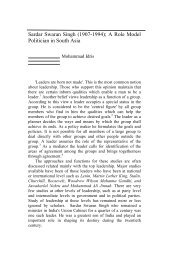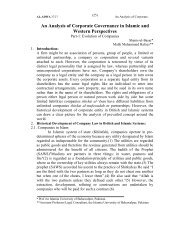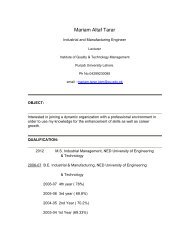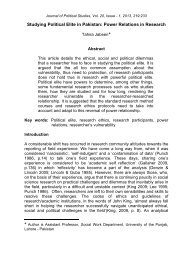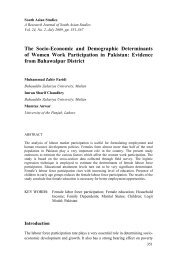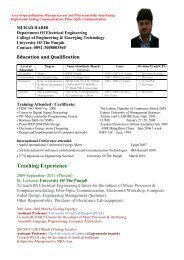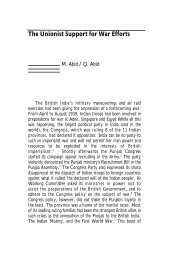pakistan geographical review 1954 - University of the Punjab
pakistan geographical review 1954 - University of the Punjab
pakistan geographical review 1954 - University of the Punjab
You also want an ePaper? Increase the reach of your titles
YUMPU automatically turns print PDFs into web optimized ePapers that Google loves.
13<br />
Jute is a regulated crop. Due to decrease in exports to India, <strong>the</strong><br />
principal buyer, <strong>the</strong> acreage under jute has decreased from 2,058 thousand acres<br />
in 1947-48 to 1,250 thousand acres in 1950-51, and 760 thousand acres in 1903-54<br />
and <strong>the</strong> yield from 68,42,605 bales m 1947-48 to 4,452,000 bales in 1950-51 and<br />
250,3000 bales in 1953-54.<br />
The area under rice has during <strong>the</strong> same period increased from 19,006,400<br />
acres in 1947-48 to 20,007,000 acres in 1950-51 and 24,533,000 acres in 1953-54<br />
and <strong>the</strong> yield from 6,736,200 tons to 7,343,000 tons 91,51,000 tons in 1953-54.<br />
This makes <strong>the</strong> province quite self-sufficient in food as its normal requirements<br />
are estimated<br />
at 72 lack tons.<br />
Tea is ano<strong>the</strong>r important crop <strong>of</strong> East Pakistan which is not produced in<br />
West Pakistan at all. In 1950-51, it covered an area <strong>of</strong> 75,000 acres and <strong>the</strong><br />
production was 37,856,000 lb=. while in 1953-54 <strong>the</strong> production was estimated at<br />
53 million lbs. By international agreement its acreage has been fixed at 83,700<br />
acres. The hot wet and humid climate <strong>of</strong> <strong>the</strong> Sylhet district in <strong>the</strong> well-drained<br />
sub-montane <strong>of</strong> <strong>the</strong> heavily forested Assam Hills, with excellent deep soils rich<br />
in burnous and iron are very favourable for tea. The slope is sufficient to<br />
give good drainage. Tea gardens are found not only on low hillocks or tilae<br />
but have also been extended to reclaimed marshlands though <strong>the</strong> product <strong>of</strong> <strong>the</strong><br />
latter is comparat ively inferior. The pre-Monsoon or early summer rains, <strong>of</strong>ten<br />
associated with Norwesters, promote <strong>the</strong> growth <strong>of</strong> new leaves. To a small<br />
extent tea is also grown in Chittagong on <strong>the</strong> low hills unfit for rice cultivation.<br />
Besides <strong>the</strong>se East Pakistan produces almost all <strong>the</strong> Pakistan's linseed<br />
and summer Til. It has an area <strong>of</strong> about 265,000 acres under betel-nut with<br />
an annual production <strong>of</strong> 9,700 tons. Rape and mustard, sugarcane and tobacco<br />
are <strong>the</strong> crops which are common to both East and West Pakistan, <strong>the</strong> first two<br />
being comparatively more important in West Pakistan and <strong>the</strong> third in East<br />
Pakistan.<br />
Taking <strong>the</strong> two wings toge<strong>the</strong>r Pakistan has a small surplus in food crops.<br />
There is an explortable surplus <strong>of</strong> about 300,000 tons <strong>of</strong> wheat and 150 to 200<br />
tons <strong>of</strong> rice. Of <strong>the</strong> cash crops in 1950-51 <strong>the</strong>re was a surplus <strong>of</strong> over 12 lakh<br />
bales <strong>of</strong> cotton and 5 million bales <strong>of</strong> Jute and 30 million lbs. <strong>of</strong> tea. These<br />
figures show that agriculturally Pakistan is a prosperous country and that this<br />
prosperity comes from <strong>the</strong> balance maintained in production in between <strong>the</strong><br />
two wings.



